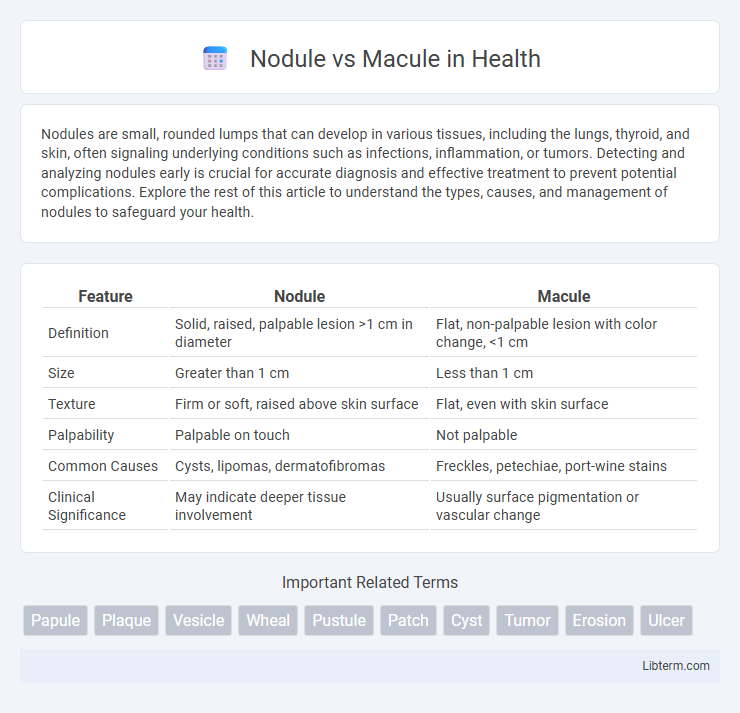Nodules are small, rounded lumps that can develop in various tissues, including the lungs, thyroid, and skin, often signaling underlying conditions such as infections, inflammation, or tumors. Detecting and analyzing nodules early is crucial for accurate diagnosis and effective treatment to prevent potential complications. Explore the rest of this article to understand the types, causes, and management of nodules to safeguard your health.
Table of Comparison
| Feature | Nodule | Macule |
|---|---|---|
| Definition | Solid, raised, palpable lesion >1 cm in diameter | Flat, non-palpable lesion with color change, <1 cm |
| Size | Greater than 1 cm | Less than 1 cm |
| Texture | Firm or soft, raised above skin surface | Flat, even with skin surface |
| Palpability | Palpable on touch | Not palpable |
| Common Causes | Cysts, lipomas, dermatofibromas | Freckles, petechiae, port-wine stains |
| Clinical Significance | May indicate deeper tissue involvement | Usually surface pigmentation or vascular change |
Introduction to Nodules and Macules
Nodules are elevated, solid skin lesions larger than 1 centimeter that extend into the dermis or subcutaneous tissue, often indicating underlying pathology such as cysts or tumors. Macules are flat, distinct, discolored spots on the skin measuring less than 1 centimeter, representing superficial pigmentation changes without thickness. Differentiating between nodules and macules is crucial for accurate dermatological diagnosis and treatment planning.
Defining Nodules: Key Characteristics
Nodules are solid, raised skin lesions typically larger than 1 centimeter in diameter, extending deeper into the dermis or subcutaneous tissue. Unlike macules, which are flat, discolorations of the skin surface without elevation, nodules possess palpable depth and firmness. These lesions often indicate underlying pathological processes such as inflammation, infection, or neoplasms and require clinical evaluation for accurate diagnosis and treatment.
Understanding Macules: Main Features
Macules are flat, distinct, discolored spots on the skin, typically less than 1 centimeter in diameter, without any elevation or depression. These lesions result from changes in pigmentation, such as melanin or vascular alterations, and do not involve alterations in skin texture. Unlike nodules, which are raised and can extend into deeper layers of the dermis, macules remain flush with the skin surface, making them a key diagnostic feature in dermatology for conditions like vitiligo or freckles.
Causes of Nodules
Nodules are caused by infections, inflammatory diseases, or neoplastic processes affecting deeper layers of the skin, such as rheumatoid arthritis, sarcoidosis, or basal cell carcinoma. These solid, raised lesions contrast with macules, which are flat and caused primarily by pigment changes like in freckles or vitiligo. Understanding the underlying cause of nodules involves assessing systemic conditions or localized skin disorders that trigger abnormal cellular growth or immune response.
Causes of Macules
Macules are flat, discolored spots on the skin caused by various factors, including sun damage, hormonal changes, infections such as pityriasis versicolor, and inflammatory conditions like eczema or lupus. Unlike nodules, which are raised and often result from cysts or tumors, macules arise from localized changes in pigmentation or vascular structures without a change in skin texture. Identifying the underlying cause of macules is essential for accurate diagnosis and effective treatment.
Clinical Appearance: Nodules vs Macules
Nodules appear as raised, firm lesions usually greater than 1 cm in diameter, often palpable and sometimes tender, indicating deeper skin involvement. Macules are flat, distinct, discolored areas of skin less than 1 cm in size without elevation or texture change, reflecting superficial pigment or vascular alterations. Clinically, nodules suggest a more advanced or infiltrative process, while macules represent early or localized surface changes.
Common Conditions Associated with Nodules
Nodules are palpable, solid lesions often found in conditions such as rheumatoid arthritis, where subcutaneous rheumatoid nodules develop, and in infectious diseases like tuberculosis, leading to tuberculous nodules in the lungs. Macules, in contrast, are flat, discolored spots commonly seen in conditions like vitiligo or freckles, without palpable elevation. Nodules are frequently associated with dermatologic disorders including cysts, benign tumors, and malignancies such as basal cell carcinoma, highlighting their clinical significance in differential diagnosis.
Diseases Linked to Macules
Macules are flat, distinct, discolored areas of skin less than 1 centimeter in diameter, often linked to diseases such as vitiligo, measles, and tinea versicolor. These lesions indicate pigmentary changes without elevation or depression, critical for diagnosing conditions like drug eruptions and secondary syphilis. Unlike nodules, macules do not involve tissue thickening or palpable masses, which distinguishes their clinical presentation in dermatological evaluations.
Diagnostic Approaches for Nodules and Macules
Diagnostic approaches for nodules often involve palpation to assess size, consistency, and depth, supplemented by imaging techniques such as ultrasound or biopsy to determine malignancy or infection. Macules are primarily evaluated through visual inspection, dermatoscopy, and sometimes Wood's lamp examination to analyze pigmentation and borders. Histopathological examination remains the definitive method for distinguishing nodules from macules and confirming underlying conditions.
Treatment and Management Options
Treatment and management of nodules primarily involve corticosteroid injections, surgical excision, or laser therapy, depending on the nodule's size, location, and underlying cause. Macules, being flat and non-palpable, often require minimal treatment; management focuses on addressing the underlying condition or cosmetic concerns through topical agents like hydroquinone or laser treatments for pigmentation issues. Regular monitoring and dermatological evaluation remain crucial for both nodules and macules to ensure appropriate intervention and prevent complications.
Nodule Infographic

 libterm.com
libterm.com